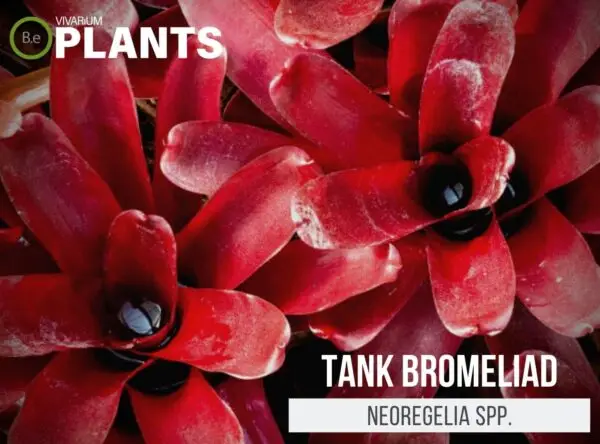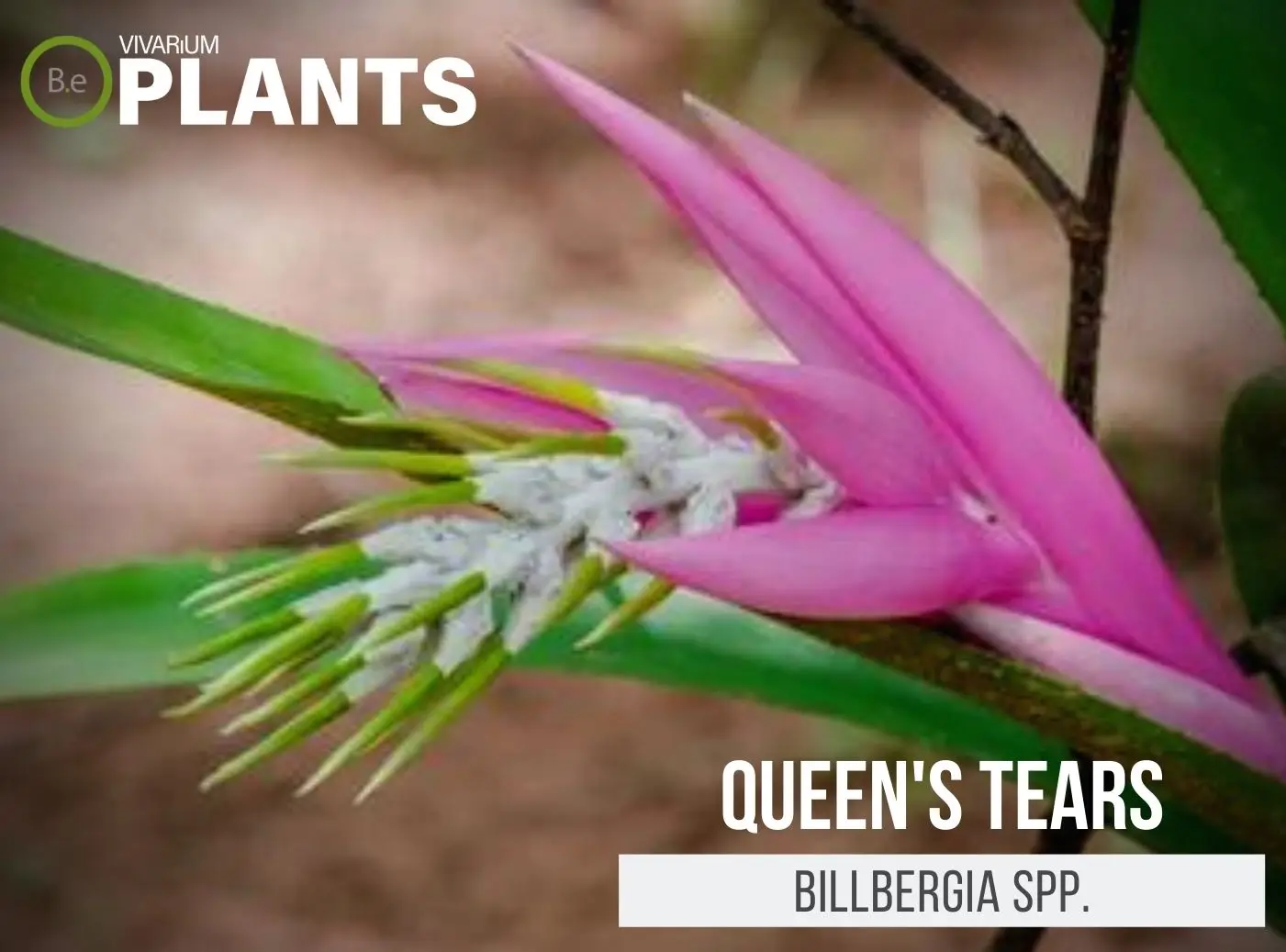Do you want to bring some tropical flair to your terrarium while also keeping it low maintenance?
Then the Neoregelia spp. is the perfect air plant for you!
These tank bromeliads are small but mighty, with beautiful foliage and vibrantly colored blooms.
Not only will they help bring the beauty of the tropics to your home, but they are also incredibly easy to care for.
Read on for some tips about how to make the most of your Neoregelia spp. terrarium plants.
Table Of Contents:
ToggleWhat is a Tank Bromeliad?
Tank bromeliads are compact plants that can grow up to 12 inches tall.
They have long, spiraling, glossy green leaves that are patterned and marked in shades of pink, yellow, red, purple, and other combinations.
It is a terrestrial species which means it needs to grow in soil but it can also grow on driftwood, rocks, and other surfaces.


Tank Bromeliad Facts
Neoregelia spp. is native to many parts of Central and South America, mainly in Brazil and the Caribbean.
Because of its wide variety of colors and shapes, it is a popular choice among hobbyists and enthusiasts alike.
Another characteristic of this plant is its ability to grow ‘offset’ which means it has more than one stem connected to the same root system.
Description
The Neoregelia spp. has long, smooth, strap-like leaves that grow from the center of the plant outwards.
The paddle-shaped leaves emerge from the middle in a spiral pattern and often form into vibrant colors of pink, yellow, purple, and red.
The plant does not have a true stem or trunk and does not need to be in a substrate for it to grow.
Habitat
Tank bromeliad can be found in several climates, ranging from subtropical to tropical regions.
It grows best in humid climates and areas of low light.
It can also survive in large rooms in homes as long as the humidity is around 60 percent and the temperature is kept consistent.
pH Preference
Neoregelia spp. prefers slightly acidic conditions with the ideal range of pH being 5.0 to 7.0.
While not strictly limited to this pH range, it is important to maintain the pH levels to ensure the plant’s health.
Vivarium Type
The tank bromeliad is quite an easy-going species.
With that in mind, it will not be too complicated when it comes to choosing the type of enclosure it is grown in.
It is best to try and replicate the plant’s natural habitat as much as possible.
Doing so will make it easier to provide this bromeliad with its basic needs.
The proper setup and theme of the enclosure will make a big difference to the overall look and health of the plant.
Be sure to choose setups that are moist and high in humidity.
Here are recommended vivariums it will do well in:
- Paludariums – Half aquatic/ half terrain-based enclosure.
- Terrariums – Fully terrain-based enclosures with little to no aquatic features.
Vivarium Placement
Tank bromeliad can be used as an accent plant in a variety of terrariums.
They are especially well suited for tropical and rainforest biotopes due to their love for high humidity.
They can be placed along the walls of the terrarium and in the mid-ground, or in the center and sides of the terrarium.
Substrate
Neoregelia spp. grows best in a substrate that allows for good drainage.
This can be achieved with a combination of both terrarium soil and gravel or sand.
When using soil, it should be mixed with looser soil such as coconut fiber or long-fiber sphagnum moss.
Lighting
Neoregelia spp. does not do well in direct sunlight and does not require high-intensity lighting.
This plant prefers to stay out of direct sunlight, preferably receiving only indirect, diffused daylight.
It is best to use a terrarium lighting fixture that has a color temperature of 5,000 to 8,000 Kelvin in order to get warm, but not harsh.
Buy Tank Bromeliad
When it comes to buying tank bromeliad, there are a few things to keep in mind.
Making sure the plant is healthy when purchased is essential for its success in a vivarium.
Vegetation that is already in poor conditions will have a very hard time adjusting to new environments.
Always make sure to buy from a reliable and honest establishment.
Click the image below to find out more about the current price and other relative info about this plant.
Tank Bromeliad Care and Propagation
Neoregelia spp. requires moderate to high humidity, so ensuring the terrarium is well covered is important.
The pads of leaves should be lightly misted with water about two or three times a week.
Wipe the leaves with a damp cloth to remove any dust or dirt.
The plant will also benefit from the occasional fertilization, but it should be done when the temperature and other conditions are right.
Propagation of tank bromeliad is done by dividing the offsets, which is a process of separating the stems that are connected to the same root system.
The offset should be cut off the main stem and replanted in the same substrate and conditions as the mother plant.
This can be done several times a year and the mother plant will consistently sprout off new offsets.
How to Grow
Tank bromeliad can be grown either in a terrarium or in an outdoor container.
When growing in a terrarium, the substrate should be moist and kept in a humid environment with temperatures between 65-85 degrees Fahrenheit.
When grown outdoors, the container should be placed in a sunny location and the soil should be kept moist with regular watering and misting.
Watering
Due to the tank bromeliad’s preference for humid conditions, it is important to keep the soil moist and the terrarium damp.
In a terrarium, the substrate should be lightly misted or watered when it starts to become dry on the surface.
When grown outdoors, the container should be watered whenever the surface of the soil begins to dry out in order to replicate the humid conditions of the terrarium.
Plants Similar to Tank Bromeliad
Adding diversity to an enclosure is key to an aesthetically pleasing setup.
Try mixing up the look of your vivarium with different flora that can easily co-exist in the same types of environment.
Furthermore, if for some reason you find the tank bromeliad is hard to acquire or would like to consider something similar to this plant…
Here are other terrarium plants you might find will do well with or in the place of Neoregelia spp.:
Conclusion
Tank bromeliad is a beautiful, low-maintenance plant that can bring a pop of color to any vivarium or outdoor container.
It can be propagated multiple times a year which allows it to take on different shapes and sizes.
The most important part of growing Neoregelia spp. is to make sure the environment is humid and avoid direct sunlight.
With a bit of diligence, tank bromeliad can make an easy-to-care-for addition to any terrarium or container garden.
Frequently Asked Questions
Yes, Neoregelia spp can take full sun. Bright, indirect light is preferred for indoor plants but full sunlight can be tolerated by Neoregelia spp outdoors.
No, Neoregelia plants do not need soil to thrive. They can be grown in purely organic materials such as sphagnum moss and bark chips. These plants mainly absorb their nutrients and water through the leaves. Expert growers may also use hydroponics or terrariums in an open–air environment.
Neoregelia should be watered once a week or when the soil is dry to the touch.
Bromeliad tanks (Neoregelia spp.) are a type of bromeliad that are native to many tropical and subtropical regions around the world. They are important because they play a key role in the ecosystem, providing shelter and food for many different species of animals, including insects, frogs, and lizards. Additionally, they are able to store water in their tanks, helping to reduce the risk of flooding in the area and providing an important water source for wildlife in times of drought.
The average lifespan of a bromeliad is 2–3 years.
It is not recommended to grow bromeliads in water. These plants are prone to rot when grown in water, as the soggy conditions are not ideal for the plant‘s health. Additionally, because most bromeliads absorb water and nutrients through the leaves rather than the roots, growing them in water offers limited nutritional value.






